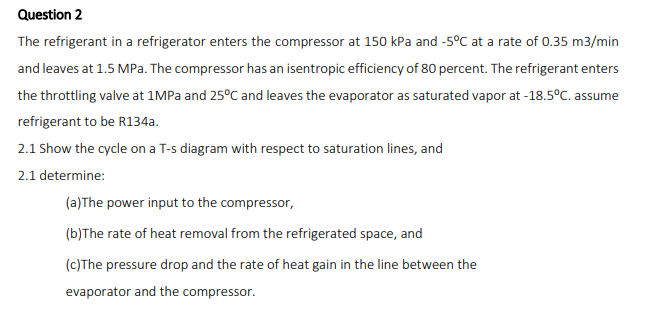Question 2 The refrigerant in a refrigerator enters the compressor at 150 kPa and -5°C at a rate of 0.35 m3/min and leaves at 1.5 MPa. The compressor has an isentropic efficiency of 80 percent. The refrigerant enters the throttling valve at 1MPA and 25°C and leaves the evaporator as saturated vapor at -18.5°C. assume refrigerant to be R134a. 2.1 Show the cycle on a T-s diagram with respect to saturation lines, and 2.1 determine: (a)The power input to the compressor, (b)The rate of heat removal from the refrigerated space, and (c)The pressure drop and the rate of heat gain in the line between the evaporator and the compressor.
Question 2 The refrigerant in a refrigerator enters the compressor at 150 kPa and -5°C at a rate of 0.35 m3/min and leaves at 1.5 MPa. The compressor has an isentropic efficiency of 80 percent. The refrigerant enters the throttling valve at 1MPA and 25°C and leaves the evaporator as saturated vapor at -18.5°C. assume refrigerant to be R134a. 2.1 Show the cycle on a T-s diagram with respect to saturation lines, and 2.1 determine: (a)The power input to the compressor, (b)The rate of heat removal from the refrigerated space, and (c)The pressure drop and the rate of heat gain in the line between the evaporator and the compressor.
Elements Of Electromagnetics
7th Edition
ISBN:9780190698614
Author:Sadiku, Matthew N. O.
Publisher:Sadiku, Matthew N. O.
ChapterMA: Math Assessment
Section: Chapter Questions
Problem 1.1MA
Related questions
Question
Hi, please answer quickly and correctly. I appreciate your assistance. Thanks in advance

Transcribed Image Text:Question 2
The refrigerant in a refrigerator enters the compressor at 150 kPa and -5°C at a rate of 0.35 m3/min
and leaves at 1.5 MPa. The compressor has an isentropic efficiency of 80 percent. The refrigerant enters
the throttling valve at 1MPA and 25°C and leaves the evaporator as saturated vapor at -18.5°C. assume
refrigerant to be R134a.
2.1 Show the cycle on a T-s diagram with respect to saturation lines, and
2.1 determine:
(a)The power input to the compressor,
(b)The rate of heat removal from the refrigerated space, and
(c)The pressure drop and the rate of heat gain in the line between the
evaporator and the compressor.
Expert Solution
This question has been solved!
Explore an expertly crafted, step-by-step solution for a thorough understanding of key concepts.
Step by step
Solved in 3 steps with 18 images

Knowledge Booster
Learn more about
Need a deep-dive on the concept behind this application? Look no further. Learn more about this topic, mechanical-engineering and related others by exploring similar questions and additional content below.Recommended textbooks for you

Elements Of Electromagnetics
Mechanical Engineering
ISBN:
9780190698614
Author:
Sadiku, Matthew N. O.
Publisher:
Oxford University Press

Mechanics of Materials (10th Edition)
Mechanical Engineering
ISBN:
9780134319650
Author:
Russell C. Hibbeler
Publisher:
PEARSON

Thermodynamics: An Engineering Approach
Mechanical Engineering
ISBN:
9781259822674
Author:
Yunus A. Cengel Dr., Michael A. Boles
Publisher:
McGraw-Hill Education

Elements Of Electromagnetics
Mechanical Engineering
ISBN:
9780190698614
Author:
Sadiku, Matthew N. O.
Publisher:
Oxford University Press

Mechanics of Materials (10th Edition)
Mechanical Engineering
ISBN:
9780134319650
Author:
Russell C. Hibbeler
Publisher:
PEARSON

Thermodynamics: An Engineering Approach
Mechanical Engineering
ISBN:
9781259822674
Author:
Yunus A. Cengel Dr., Michael A. Boles
Publisher:
McGraw-Hill Education

Control Systems Engineering
Mechanical Engineering
ISBN:
9781118170519
Author:
Norman S. Nise
Publisher:
WILEY

Mechanics of Materials (MindTap Course List)
Mechanical Engineering
ISBN:
9781337093347
Author:
Barry J. Goodno, James M. Gere
Publisher:
Cengage Learning

Engineering Mechanics: Statics
Mechanical Engineering
ISBN:
9781118807330
Author:
James L. Meriam, L. G. Kraige, J. N. Bolton
Publisher:
WILEY